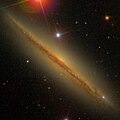| NGC 4217 | |
|---|---|
 This is galaxy NGC 4217 with foreground stars from the Milky Way. | |
| Observation data (J2000 epoch) | |
| Constellation | Canes Venatici |
| Right ascension | 12h 15m 50.900s [1] |
| Declination | +47° 05′ 30.44″ [1] |
| Redshift | 0.003419 [2] |
| Heliocentric radial velocity | 1023 km/s [2] |
| Distance | 61.6 Mly (18.88 Mpc) [3] |
| Apparent magnitude (B) | 12.4 [2] |
| Characteristics | |
| Type | Sb [4] |
| Apparent size (V) | 5.012′ × 1.479′ [5] |
| Other designations | |
| UGC 7282, MCG +08-22-087, PGC 39241 [2] | |
NGC 4217 is an edge-on spiral galaxy which lies approximately 60 million light-years (18 million parsecs) away in the constellation of Canes Venatici. [3] It is a possible companion galaxy[ citation needed ] to Messier 106 (NGC 4258).
Contents
One supernova, SN 2022myz (type I, mag. 19), was discovered in NGC 4217 on 19 June 2022. [6]



